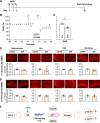Long-Term Depression-Inducing Low Frequency Stimulation Enhances p-Tau181 and p-Tau217 in an Age-Dependent Manner in Live Rats
- PMID: 35871344
- PMCID: PMC9484260
- DOI: 10.3233/JAD-220351
Long-Term Depression-Inducing Low Frequency Stimulation Enhances p-Tau181 and p-Tau217 in an Age-Dependent Manner in Live Rats
Abstract
Background: Cognitive decline in Alzheimer's disease (AD) correlates with the extent of tau pathology, in particular tau hyperphosphorylation, which is strongly age-associated. Although elevation of cerebrospinal fluid or blood levels of phosphorylated tau (p-Tau) at residues Thr181 (p-Tau181), Thr217 (p-Tau217), and Thr231 (p-Tau231) are proposed to be particularly sensitive markers of preclinical AD, the generation of p-Tau during brain activity is poorly understood.
Objective: To study whether the expression levels of p-Tau181, p-Tau217, and p-Tau231 can be enhanced by physiological synaptic long-term depression (LTD) which has been linked to the enhancement of p-Tau in hippocampus.
Methods: In vivo electrophysiology was performed in urethane anesthetized young adult and aged male rats. Low frequency electrical stimulation (LFS) was used to induce LTD at CA3 to CA1 synapses. The expression level of p-Tau and total tau was measured in dorsal hippocampus using immunofluorescent staining and/or western blotting.
Results: We found that LFS enhanced p-Tau181 and p-Tau217 in an age-dependent manner in the hippocampus of live rats. In contrast, phosphorylation at residues Thr231, Ser202/Thr205, and Ser396 appeared less sensitive to LFS. Pharmacological antagonism of either N-methyl-D-aspartate or metabotropic glutamate 5 receptors inhibited the elevation of both p-Tau181 and p-Tau217. Targeting the integrated stress response, which increases with aging, using a small molecule inhibitor ISRIB, prevented the enhancement of p-Tau by LFS in aged rats.
Conclusion: Together, our data provide a novel in vivo means to uncover brain plasticity-related cellular and molecular processes of tau phosphorylation at key sites in health and aging.
Keywords: Aging; Alzheimer’s disease; integrated stress response; long-term depression; tau phosphorylation.
Conflict of interest statement
Authors’ disclosures available online (
Figures





Similar articles
-
Do tau-synaptic long-term depression interactions in the hippocampus play a pivotal role in the progression of Alzheimer's disease?Neural Regen Res. 2023 Jun;18(6):1213-1219. doi: 10.4103/1673-5374.360166. Neural Regen Res. 2023. PMID: 36453396 Free PMC article. Review.
-
Comparison of Plasma Phosphorylated Tau Species With Amyloid and Tau Positron Emission Tomography, Neurodegeneration, Vascular Pathology, and Cognitive Outcomes.JAMA Neurol. 2021 Sep 1;78(9):1108-1117. doi: 10.1001/jamaneurol.2021.2293. JAMA Neurol. 2021. PMID: 34309632 Free PMC article.
-
Association of BDNF Val66Met With Tau Hyperphosphorylation and Cognition in Dominantly Inherited Alzheimer Disease.JAMA Neurol. 2022 Mar 1;79(3):261-270. doi: 10.1001/jamaneurol.2021.5181. JAMA Neurol. 2022. PMID: 35099506 Free PMC article.
-
Comparing the Clinical Utility and Diagnostic Performance of CSF P-Tau181, P-Tau217, and P-Tau231 Assays.Neurology. 2021 Oct 26;97(17):e1681-e1694. doi: 10.1212/WNL.0000000000012727. Epub 2021 Sep 7. Neurology. 2021. PMID: 34493616 Free PMC article.
-
Phosphorylated tau in Alzheimer's disease.Adv Clin Chem. 2023;116:31-111. doi: 10.1016/bs.acc.2023.05.001. Epub 2023 Jun 9. Adv Clin Chem. 2023. PMID: 37852722
Cited by
-
Patient-derived tau and amyloid-β facilitate long-term depression in vivo: role of tumour necrosis factor-α and the integrated stress response.Brain Commun. 2024 Sep 27;6(5):fcae333. doi: 10.1093/braincomms/fcae333. eCollection 2024. Brain Commun. 2024. PMID: 39391333 Free PMC article.
-
Do tau-synaptic long-term depression interactions in the hippocampus play a pivotal role in the progression of Alzheimer's disease?Neural Regen Res. 2023 Jun;18(6):1213-1219. doi: 10.4103/1673-5374.360166. Neural Regen Res. 2023. PMID: 36453396 Free PMC article. Review.
-
ISR Modulators in Neurological Diseases.Curr Neuropharmacol. 2025;23(10):1184-1214. doi: 10.2174/011570159X361653250213114821. Curr Neuropharmacol. 2025. PMID: 39995125 Free PMC article. Review.
References
-
- Wesseling H, Mair W, Kumar M, Schlaffner CN, Tang S, Beerepoot P, Fatou B, Guise AJ, Cheng L, Takeda S, Muntel J, Rotunno MS, Dujardin S, Davies P, Kosik KS, Miller BL, Berretta S, Hedreen JC, Grinberg LT, Seeley WW, Hyman BT, Steen H, Steen JA (2020) Tau PTM profiles identify patient heterogeneity and stages of Alzheimer’s disease. Cell 183, 1699–1713. - PMC - PubMed
Publication types
MeSH terms
Substances
LinkOut - more resources
Full Text Sources
Medical
Miscellaneous

